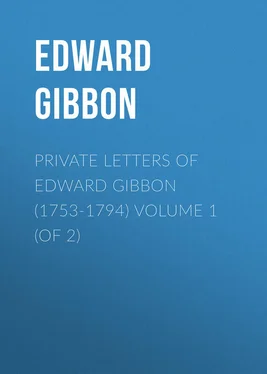Edward Gibbon - Private Letters of Edward Gibbon (1753-1794) Volume 1 (of 2)
Здесь есть возможность читать онлайн «Edward Gibbon - Private Letters of Edward Gibbon (1753-1794) Volume 1 (of 2)» — ознакомительный отрывок электронной книги совершенно бесплатно, а после прочтения отрывка купить полную версию. В некоторых случаях можно слушать аудио, скачать через торрент в формате fb2 и присутствует краткое содержание. Жанр: foreign_antique, foreign_prose, на английском языке. Описание произведения, (предисловие) а так же отзывы посетителей доступны на портале библиотеки ЛибКат.
- Название:Private Letters of Edward Gibbon (1753-1794) Volume 1 (of 2)
- Автор:
- Жанр:
- Год:неизвестен
- ISBN:нет данных
- Рейтинг книги:3 / 5. Голосов: 1
-
Избранное:Добавить в избранное
- Отзывы:
-
Ваша оценка:
- 60
- 1
- 2
- 3
- 4
- 5
Private Letters of Edward Gibbon (1753-1794) Volume 1 (of 2): краткое содержание, описание и аннотация
Предлагаем к чтению аннотацию, описание, краткое содержание или предисловие (зависит от того, что написал сам автор книги «Private Letters of Edward Gibbon (1753-1794) Volume 1 (of 2)»). Если вы не нашли необходимую информацию о книге — напишите в комментариях, мы постараемся отыскать её.
Private Letters of Edward Gibbon (1753-1794) Volume 1 (of 2) — читать онлайн ознакомительный отрывок
Ниже представлен текст книги, разбитый по страницам. Система сохранения места последней прочитанной страницы, позволяет с удобством читать онлайн бесплатно книгу «Private Letters of Edward Gibbon (1753-1794) Volume 1 (of 2)», без необходимости каждый раз заново искать на чём Вы остановились. Поставьте закладку, и сможете в любой момент перейти на страницу, на которой закончили чтение.
Интервал:
Закладка:
Footnote_91_91
Theophilus Bolton, who was making the tour with Mr. Holroyd and Major Ridley, died of consumption at Genoa.
Footnote_92_92
Son of Sir Matthew Ridley, Bart., Major in the Welsh Fusiliers. He had served in Germany during the Seven Years' War, and was at this time Mr. Holroyd's travelling companion.
Footnote_93_93
M. Deyverdun had known Gibbon at Lausanne, and from 1766-69 was a frequent guest at Beriton. With his assistance Gibbon published the Mémoires Littéraires de la Grande Bretagne pour l'an 1767 (Londres: Chez T. Becket and P. A. de Hondt dans le Strand, 1767), which were discontinued in 1768, when Deyverdun, on his friend's recommendation, left England as tutor to the son of Sir T. Worsley, afterwards the Right Hon. Sir Richard Worsley. In 1783 Gibbon took up his abode with Deyverdun at the latter's house at Lausanne. Deyverdun died in July, 1789, leaving his house and land by will to Gibbon for his life.
Footnote_94_94
Lady Diana Spencer married in 1757 Frederick St. John, Lord Bolingbroke, the "Bully" who figures in George Selwyn's correspondence, from whom she was divorced, March 10, 1768. Two days later she married Topham Beauclerk, grandson of the first Duke of St. Albans, the friend of Dr. Johnson, and the collector of a magnificent library. During his long illness she nursed him, as Johnson, no friendly witness, admits, "with very great assiduity." He died in 1780. Lady Diana, whose skill as an artist is frequently alluded to by Walpole, died in 1808.
Footnote_95_95
Hugh, Lord Warkworth, eldest son of Sir Hugh Smithson, Bart., of Stanwick, who was created Duke of Northumberland in 1766, married July 2, 1764, Lady Anne Stuart, third daughter of the Earl of Bute. They were divorced in 1779. As Earl Percy he served in the American War at the battle of Lexington and elsewhere.
Footnote_96_96
See note to Letter 126.
Footnote_97_97
Sir James Lowther, Bart., first Earl of Lonsdale, married (1761) Lady Mary Stewart, eldest daughter of the Earl of Bute, and sister of Lady Warkworth.
Footnote_98_98
Dr. William Heberden (1710-1801), one of the most famous physicians of the century, and a distinguished scholar. He was called by Dr. Johnson "Ultimus Romanorum" (a title which might be as justly applied to Sir H. Halford), as being "the last of our learned physicians." He is hailed by Cowper as "virtuous and faithful," perhaps because, as Dr. G. B. Hill suggests, he bought and destroyed an unpublished manuscript by Dr. Middleton on The Inefficacy of Prayer .
Footnote_99_99
Up Park, near Stansted in Sussex, the seat of Sir Matthew Featherstonhaugh, F.R.S., formerly M.P. for Morpeth, at this time M.P. for Portsmouth; Port Eliot, St. Germans, Cornwall, that of Gibbon's cousin, Mr. Edward Eliot, M.P. for Liskeard, afterwards for Cornwall, created in 1784 Baron Eliot of St. Germans; and Hartley Manduit that of Sir Simeon Stuart, M.P. for the county of Southampton.
Footnote_100_100
Under Lord Bute, the Ministerial Club, as it was at first called, used to meet at the Cocoa Tree Tavern, in St. James's Street. In 1745 it had been the great resort of the Jacobites. Gibbon describes a supper at the club in his Journal for November, 1762. [ Memoirs of My Life and Writings – Miscellaneous Works , vol. i. p. 154 (second edition, 1814).] By the "School of Vice" it is more than probable Gibbon meant White's Club, formed in 1736, at this time the great Tory gaming club. It contained within its walls an Old and a Young Club, the Old being recruited from among the members of the Young. Hence, perhaps, arose its name of the "School of Vice."
Footnote_101_101
The Stamp Act, charging stamp duties on all legal documents executed in the Colonies, received the royal assent March 22, 1765, and came into operation November 1, 1765. When Parliament reassembled on January 14, 1766, Pitt attacked the policy of the Act. General Conway, one of the Secretaries of State, who replied to him, said that the sentiments which he had expressed were substantially those of the ministers, and that, for his own part, he would gladly resign his office if Pitt would take it. Grenville, who followed, defended the Act, and it was in reply to him, on the same evening, that Pitt delivered one of the most eloquent and famous of his speeches. Ireland took a keen interest in the question, and the debate happens to be fully reported by two Irish gentlemen, Sir Robert Dean and Lord Charlemont; otherwise, like many others of the time, it might have passed without record. In the same session, February 24 to March 17, two resolutions were carried in both Houses, one declaring the right of Great Britain to tax the Colonies, the other repealing the Stamp Act. Two Acts of Parliament expressed these resolutions in legislative form.
Footnote_102_102
The name was so spelt in the newspapers. John Baker Holroyd married in 1767 Miss Abigail Way, only daughter of Lewis Way, of Richmond, Surrey.
Footnote_103_103
The motto of the regiment of light dragoons, called Royal Foresters, in which Mr. Holroyd had been captain, and which was disbanded in 1763.
Footnote_104_104
A nickname for Mr. Guise.
Footnote_105_105
At Southampton Gibbon attended every spring the monthly exercise of the militia, of which, by the resignation of his father and the death of Sir T. Worsley (1768), he eventually became lieutenant-colonel commandant.
Footnote_106_106
Parliament was dissolved March 11, 1768, and the elections took place in March. Gibbon seems to have assisted the Worsleys in the Isle of Wight against the Castle interest and that of the Holmes family. In 1586, when the Crown sought to create a parliamentary party in the House of Commons, six members were returned to Parliament by the three boroughs of Newport, Newtown, and Yarmouth, because in the Isle of Wight, through its military captain and governor, the influence of the Crown was paramount. Gradually the leading families of the island acquired control over the three boroughs, and at this period they were disputed by the Worsley, Barrington, and Holmes families, the latter being descended from Sir Robert Holmes, who took New York from the Dutch, and "first bewitched our eyes with Guinea gold." At the election of 1768 the following members were elected for the respective boroughs: – Newport: Hans Sloane, Esq., and John Eames, Esq., one of the Masters in Chancery. Newtown: Sir J. Barrington, Bart., and Harcourt Powell, Esq. (re-elected). Yarmouth: Jervoise Clarke, Esq., and William Strode, Esq.
Footnote_107_107
A convivial club, meeting once a week, established by Gibbon and other travellers.
Footnote_108_108
Gibbon was a member of Boodle's Club, known as the Savoir vivre .
Footnote_109_109
Ranelagh Gardens, now part of Chelsea Hospital Gardens, stood on the site of a villa belonging to Lord Ranelagh, the Jones of Grammont's Memoirs . The Rotunda, an amphitheatre, with an orchestra in the centre, surrounded by "balconies full of little alehouses," was opened to the public May 24, 1742. The last entertainment given there was the installation ball of the Knights of the Bath in 1802. The gardens were closed in 1803. A staple, fixed in one of the trees of the avenue, preserved, till a few years ago, the traditions of the glories of Ranelagh when the gardens were lighted by a thousand lamps.
Читать дальшеИнтервал:
Закладка:
Похожие книги на «Private Letters of Edward Gibbon (1753-1794) Volume 1 (of 2)»
Представляем Вашему вниманию похожие книги на «Private Letters of Edward Gibbon (1753-1794) Volume 1 (of 2)» списком для выбора. Мы отобрали схожую по названию и смыслу литературу в надежде предоставить читателям больше вариантов отыскать новые, интересные, ещё непрочитанные произведения.
Обсуждение, отзывы о книге «Private Letters of Edward Gibbon (1753-1794) Volume 1 (of 2)» и просто собственные мнения читателей. Оставьте ваши комментарии, напишите, что Вы думаете о произведении, его смысле или главных героях. Укажите что конкретно понравилось, а что нет, и почему Вы так считаете.












